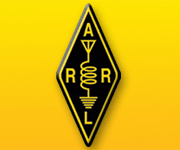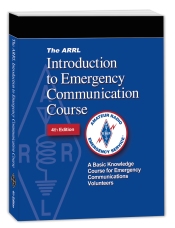As Hurricane Sandy Wreaks Havoc on East Coast, Hams Heed Call to Help
Article posed from ARRL.org dated 11/01/2012.
To receive all articles, sign up at
www.ARRL.org.

Even though Hurricane Sandy was declared a post-tropical cyclone by the time it made its final landfall -- just 5 miles southwest of Atlantic City, New Jersey at about 8 PM EDT on Monday, October 29 -- the storm still had winds in excess of 80 miles per hour. Hams across the region, from the Carolinas to Maine, responded to requests for assistance and activated local nets, supported the Hurricane Watch Net’s and the VoIP Hurricane Net’s operations, assisted their local and state Emergency Operations Centers and provided assistance at shelters and wherever needed.
New Jersey
Northern New Jersey
Two hospitals in New Jersey requested assistance from radio amateurs. According to ARRL Northern New Jersey Section Emergency Coordinator George Sabbi, KC2GLG, the hospitals were experiencing issues with their communications systems they use for direct communications between these their facilities in Middlesex and Union Counties.
Sabbi said that a shelter in Bergen County utilized radio amateurs when it opened on Monday, October 29 until late in the morning the next day. “Operators went off duty for rest and came back on Tuesday. The Red Cross is working on getting more Amateur Radio resources into additional shelters, noting that travel is a restriction for many volunteers due to the numerous road closures all over the state. I’ve received several reports of repeaters being on backup power or off-the-air, and in all cases, we’ve moved to alternate frequencies.”
Southern New Jersey
Through its Ham Aid program, the ARRL sent six VHF radios to Ocean County, New Jersey. ARRL Ocean County Emergency Coordinator Bob Murdock, WX2NJ, programmed them for deployment to the six shelters in Ocean County shelters today. One of the ARRL’s National VOAD partners, NECHAMA -- Jewish Response to Disaster, provided transportation to Ocean County.
ARRL Southern New Jersey Section Emergency Coordinator John Zaruba, K2ZA, ran a Section Resource net on the SNJ ARES repeater at 7 AM, 1 PM and 7 AM each day to provide support to the County Emergency Coordinators. He sent requests, asking for six relief operators from within the Section to deploy to Atlantic County and another six relief operators to go to Ocean County. Both shoreline counties used Amateur Radio in the shelters run by the American Red Cross.
“As of Wednesday, October 31, commercial communications are coming back on line in the inland counties, with some counties, such as Mercer County, starting to use radio amateurs to assist in damage assessment as roads become more passable,” explained ARRL Southern New Jersey Section Manager Gary Wilson, K2GW. “The other counties are being polled for mutual aid operator support to Ocean and Atlantic County. I believe John is also starting communications with the Eastern Pennsylvania, Northern New Jersey and Western Massachusetts Sections about their eventually providing relief operators.”
Wilson said that the NJ2EM operation at the New Jersey State Police’s State Office of Emergency Management was secured on October 31, “as they have commercial contact now with all of the county EOCs, although their statewide 220 MHz repeater is still available for county-to-county communication.”
On Thursday, November 1, Wilson told the ARRL that the “communications emergency” in the nine counties that make up the ARRL’s Southern New Jersey Section is over. “While the recovery will take a long time, commercial communications systems are being restored in most parts of the Section,” he said. “Amateur Radio emergency operations are continuing in Ocean and Atlantic Counties under the direction of their County Emergency Coordinators.”
Ocean County Emergency Coordinator Bob Murdock, WX2NJ, said that the six shelters in the county are being consolidated into one shelter. “At this time, he thinks the one last shelter might remain operational for about a week,” Wilson said. “The ARRL Ham Aid VHF radios are working great there. In Atlantic County, Emergency Coordinator John Miller, KC2TNV, reported that relief operators are needed to give the operators a needed rest. Zaruba is currently polling the other counties in the Section for mutual aid operator support to Atlantic County. Both shoreline counties will continue to determine their long-term Amateur Radio needs on a daily basis, based on the American Red Cross’ sheltering plans and the state of commercial communication restoration.”
Wilson told the ARRL that one of the reasons that New Jersey is somewhat better prepared than other states is that New Jersey Office of Emergency Management won’t approve a County Emergency Management Plan unless it includes a RACES annex. “As a result, every county EOC has permanent Amateur Radio capability on 2 meters simplex, a 220 MHz radio aimed at the NJ2EM 220 MHz repeater that covers the entire state, 2 meter APRS for text messaging and HF capability on 75 meters LSB,” he explained. “These are tested once each month on statewide nets. Similarly each American Red Cross chapter tests its 2 meter capability monthly with the central Red Cross station at N2ARC in Princeton, which then links to the State Emergency Operations Center in West Trenton. And of course, each county has a 2 meter repeater designated for their own work at the county level.”
Wilson thanked all of the ARES/RACES operators in Southern New Jersey Section: “You showed that planning, regular monthly tests and dedication pay off when it comes to helping our fellow citizens in a communication emergency. When all else fails, Amateur Radio works!”
Eastern New York
The Eastern New York Section Coordination Net on the N2ACF system operated throughout Hurricane Sandy, concluding their operations on Tuesday at noon. According to ARRL Eastern New York Section Emergency Coordinator David Galletly, KM2O, Section leadership assessed the incoming reports and determined the duration of continued operations following the passage of Sandy through the Section when the net resumed on Tuesday morning. Even though the formal nets are over, the system will still be available for informal use by those stations that still need emergency communication coordination.
Galletly asked the Emergency Coordinators in the Sections to check in to the net when it resumes “to report on continued deployments and support activities. Using this information we will try to determine if any reallocation of operators by mutual aid is needed and prepare requests for shifting resources to areas in greatest need.”
Following a request from Westchester County Emergency Coordinator Tom Raffaelli, WB2NHC, operators from the Northern and Central Districts in the ARRL’s Eastern New York Section have begun to deploy to relieve Westchester operators. Galletly and Central District Emergency Coordinator Leonard Signoretti, N2LEN, arrived in Westchester on Thursday, November 1, to provide relief shelter duty. Operators from Albany will arrive in Westchester later on Thursday. Galletly said that he is requesting additional relief operators from other counties in the Section.
Connecticut
Hams associated with SKYWARN were very active in Connecticut. “Assistant District Emergency Coordinator for SKYWARN Jim McBride, KD1LD, kept all of us updated about current conditions and did a great job working with our very dedicated SKYWARN Emergency Coordinators who coordinated activity in their counties,” explained ARRL Connecticut Section Manager Betsey Doane, K1EIC. “We had hams in Hartford, Fairfield, New London and Windham Counties who participated in the SKYWARN nets. We needed a fill-in for New Haven County, so Craig Lang, W1MHZ, spontaneously volunteered, even under his own emergency conditions. He ran a few nets while camped out at his neighbor’s home; as I understand it, he had to be evacuated. His work was commendable.”
Many shelters throughout the Section were supported by radio amateurs, some of whom are also CERT trained. Stamford Emergency Coordinator Jon Perelstein, WB2RYV, reported that eight volunteers and two American Red Cross disaster leaders -- most of whom are members of the Stamford Amateur Radio Association -- supported the three Stamford shelters, provided backup communications for Red Cross between the shelters, the Emergency Operations Center and the Red Cross chapter house in Darien. Those staffing the shelters did everything from intake to cooking to support for the elderly and infirm. Other hams staffed the Citizen Service Line, also in Stamford. This service provides a way for Stamford residents to phone in and request information about evacuation plans. The hams also took reports of downed trees and power lines for dispatch of Connecticut Light & Power and city work crews.
“While backup communications were not needed during Hurricane Sandy, we had operators at all the shelters in the area, at the EOC and at the Darien Red Cross chapter house,” Doane said. “Our ham volunteers also became involved as ‘expediters’ in dealing with various problems, such as untangling a (non-radio) communications issue that was interfering with food deliveries to the Stamford shelters. In the aftermath of the storm, the Stamford Mayor Michael Pavia was careful to single out SARA participants to various visiting politicians, including US Senator Richard Blumenthal. Both the mayor and the Director of Public Safety made specific mention of amateur radio in thanking the various volunteer groups who helped the city.”
In the western part of the state, Danbury Emergency Coordinator Mark Hertzbert, WA2IZQ, and his ARES group staffed the Danbury Emergency Operations Center, the shelter at the War Memorial and Danbury Hospital. “They served as backup communicators and were generally useful to the served agencies in tasks that were not necessarily communication-related,” Doane explained. “Everyone participated in continually assessing the situation in their areas of responsibility.”
North Carolina
According to ARRL North Carolina Section Emergency Coordinator/North Carolina RACES Officer Tom Brown, N4TAB, ARES groups in the state participated in response to Hurricane Sandy activities. “Local teams operated during the response-and-recovery phases at several County Emergency Operations Centers and at the State EOC at Raleigh; all operators participated under the NIMS/ICS model,” he said. “The AUXCOMM team at the State EOC operated under the ALL HAZARDS model and we had several Communication Leaders (COMLs) and a Communication Technician (COMT) from our own resource group on duty at all times.”
Delaware
ARRL Delaware Section Manager Frank Filipkowski, AD3M, thanked all those in his Section who provided assistance: “I wish to thank all members in the ARRL Delaware Section for volunteering their time and effort in support of radio communications efforts during and after Hurricane Sandy. The members who left their loved ones behind to volunteer at emergency shelters and Emergency Operation Centers, police and fire stations get my heartfelt ‘thank you’ for your extra effort during our communities’ urgent need to leave their homes and families behind to support the greater good serving your community. It is at times like these that it makes me proud to be a member of citizen volunteers who give back their time knowledge equipment and love of their hobby to support their community.”
Ohio
There was rain, high winds, localized flooding and power outages in Northwest Ohio. ARRL Ohio Section Emergency Coordinator Matthew Welch, W8DEC, told the ARRL that ARES members were activated in Jefferson County to monitor the level of the Ohio River. In Lorain County, the American Red Cross requested assistance from the local ARES group to provide communications assistance for two shelters.
 Hurricane Sandy Spawns Lessons Learned for Connecticut ARES
Hurricane Sandy Spawns Lessons Learned for Connecticut ARES










